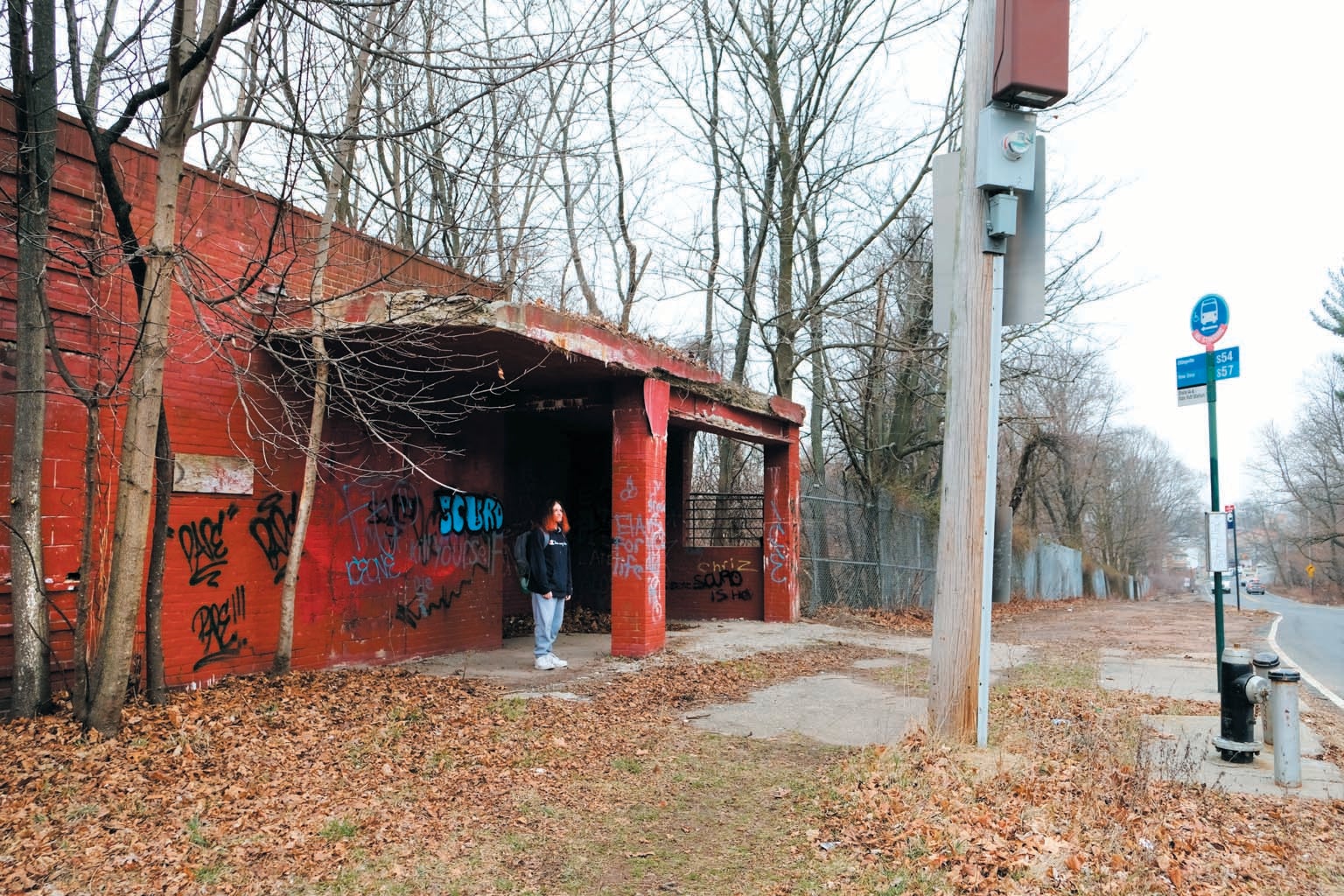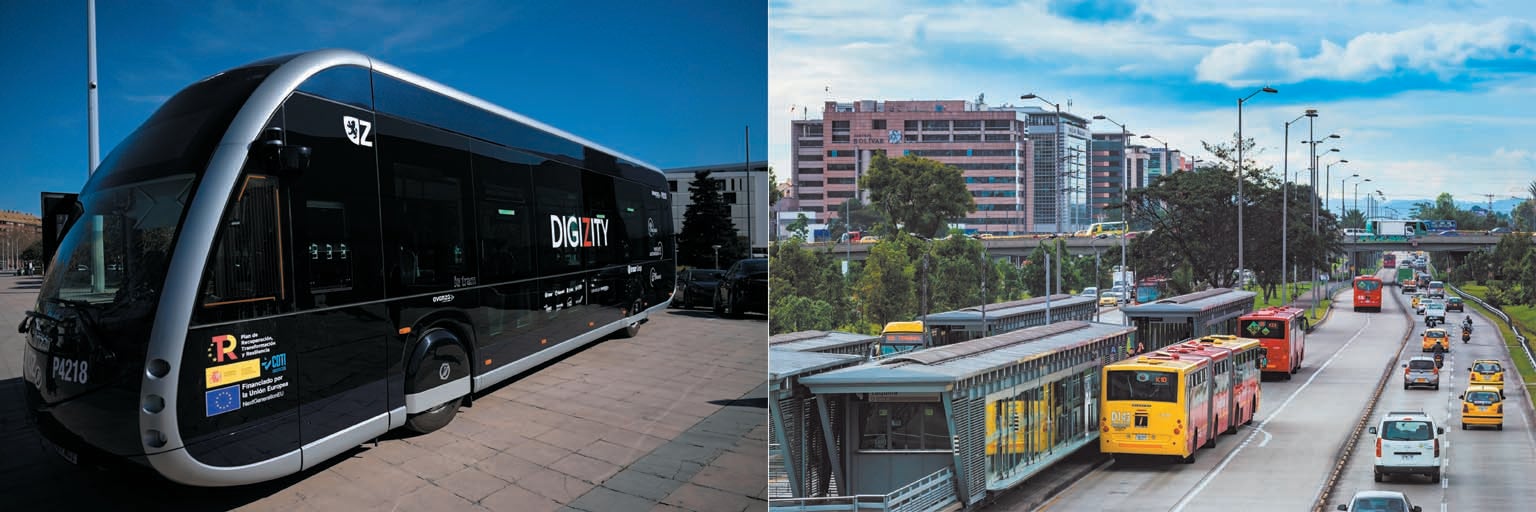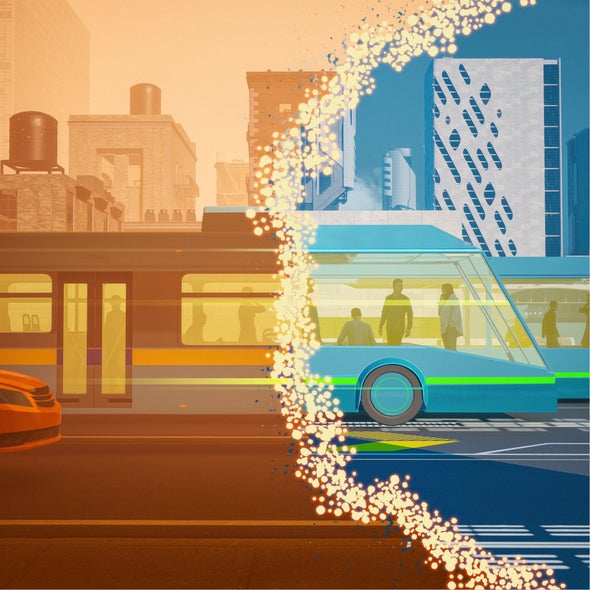For the past decade Seattle has been growing—fast. Between 2010 and 2020 its population swelled by almost a quarter. Growth is generally good for cities, but it is often accompanied by a dreaded problem: traffic. Yet Seattle managed to avert this crisis, cutting traffic in its downtown by 10 percent and reducing greenhouse gas emissions in the process. How did Seattle do it? By turning to an uncommon solution: the humble bus.
Buses are among the most overlooked solutions for decarbonizing the U.S. Transportation is the single largest source of greenhouse gas emissions, making up slightly less than 30 percent, according to the Environmental Protection Agency. In the summer of 2022 more than 5 percent of new auto sales in the U.S. were for all-electric vehicles (EVs), signaling that electric-car ownership had shifted from being a fad of early adopters to a transportation staple. Three of the four car commercials that aired during this year's Super Bowl were for EVs. In January, President Joe Biden tweeted, “On my watch, the great American road trip is going to be fully electrified,” alongside a photograph of himself behind the wheel of an electric Hummer.
The president has supported EVs as part of the nation's climate plan, pledging to reduce emissions by 50 to 52 percent by 2030. This commitment is in line with the aims of the Paris Agreement. But Steven Higashide, director of the Clean Transportation program at the Union of Concerned Scientists, cautions that “electrifying personal vehicles is necessary but not sufficient” for achieving the nation's goals on climate change reduction.
A growing body of research bolsters his point. A 2018 report by the California Air Resources Board found that the state could not meet its 2030 climate goals through vehicle electrification alone. At the time, California aimed to reduce greenhouse gas emissions to 40 percent of the state's 1990 levels by 2030. But according to the report, even if there were 10 times as many EVs on the road, people would still need to reduce their driving by 25 percent for California to reach its target.

The culprit is something known as vehicle fleet turnover—that is, how long it takes to shift the mix of vehicles that are on the road. Even if every new vehicle sold from now on were electric and directly replaced a gas-powered car, it would still be at least 15 years before virtually every car on the road was electric. But sales of new gas cars are still higher than those of EVs, which is why even the more ambitious estimates say roughly a third of cars will still be gas in 2050.
Even if the U.S. could somehow avoid the fleet-turnover problem, swapping gas cars one-for-one with EVs would create new energy needs requiring half of the country's electricity-generating capacity, according to a 2020 analysis in the journal Nature Climate Change. This demand would limit the nation's ability to power other things such as air-conditioning that are necessary for health and safety in a warming world. To meet the country's climate goals, Higashide says we'll have to drive less frequently and for shorter distances—and redesign cities and neighborhoods with good mass transit options.
Buses can fill a lot of those needs. It's better if they're powered by electric batteries, but even gas buses reduce emissions with enough riders. On average, cars emit almost one pound of carbon dioxide per passenger mile. Buses, which generally run at about 25 percent capacity, emit 0.64 pound of CO2 per passenger mile, according to data from the Department of Defense. If they ran full, buses would emit 0.18 pound of CO2 per passenger mile, making them comparable to rail but at a much lower cost. “I think the bus is often overlooked as a climate solution,” Higashide says, “because it is overlooked as a solution, period.”
Converting drivers to riders
Buses have long been maligned in popular imagination. In movies and television shows, scriptwriters often have characters ride the bus to telegraph to viewers that they are facing tough times. On the HBO series Insecure, main character Issa Dee's downward spiral begins with her crashing her car and having to ride the bus. In the ultimate bus flick, Speed, Annie is on the bus because her driver's license has been revoked—for speeding. Why else would a nice girl like her be riding the bus in Los Angeles?
It would seem that buses are a hard sell in a country that loves the automobile, but research suggests that isn't necessarily true. According to a 2016 analysis led by Higashide that looked at transit-ridership behavior among both car owners and those without cars, people who live near better transit ride it more often regardless of whether they own a vehicle. The problem is that many Americans do not live near better transit. An analysis by the American Society of Civil Engineers found that 45 percent of people in the U.S. lack access to transit at all. Those who do have transit available find it is often slow and unreliable.
The amount of time between buses or trains at a given stop, known as headway, has a huge impact on whether people will actually use the service. “Ten minutes is that magic mark,” says Kari Watkins, an associate professor of civil and environmental engineering at the University of California, Davis. Watkins's research looks at how to expand mobility through methods other than driving. When a bus arrives every 10 minutes or less, riders don't have to think about when the bus is coming. This experience mirrors the main convenience of private car ownership: transportation is available when you need it.
When buses arrive every 15 or 20 minutes, “people are still going to feel like they have to time their trips,” Watkins says. Past that, “anybody who has a choice is not as likely to opt for transit.” Buses that arrive with an unpredictable cadence because of traffic and other factors also turn people away.
In this way, trains have some benefits over buses because they run on a fixed schedule. The two modes are probably best used in a complementary way: rail can carry large numbers of people in denser communities, and buses can serve to funnel people to those rail lines. Even in New York City—a place well known for its subway system—buses shuttle more than one million riders daily. Buses are also much nimbler than trains because they leverage an existing piece of infrastructure: the road. Routes can be adjusted to meet shifting needs, whereas train tracks cannot be moved.
Yet “in many parts of the country, there has been an investment in rail without the corresponding investment in bus service,” Higashide says. He points to Denver: the city has spent billions expanding its light rail and commuter rail systems, but “then you get off the train, and the bus comes every hour.”
David King, a planning professor at Arizona State University, thinks transit service, especially bus transit, is so poor in the U.S. partly because it's treated as a social or public service—a form of government support or assistance for disadvantaged people. Nationwide, transit riders are more likely to have lower incomes than drivers, and among people who ride, those who take the train tend to have higher incomes than bus passengers. Bus riders are more likely to be people with no other option.
“We usually call them transit-dependent riders,” says Candace Brakewood, an associate professor in the department of civil and environmental engineering at the University of Tennessee, Knoxville. “They often are low income, can't afford a car or perhaps have a disability, and can't drive or really don't want to drive.” Research shows, however, that if service is bad enough, even those who are ostensibly transit-dependent will find other ways of getting around, such as walking, biking, hitching rides and using informal transit networks.
In many cities, buses are treated as critical infrastructure. Take Bogotá, Colombia, for instance, which has no metro service and has roughly the same size population as New York City. The bus rapid transit system, TransMilenio, has priority lanes that shuttle passengers faster than private cars during peak traffic periods. Sleek, well-lit stations were carefully planned to be accessible by sidewalk as well as by bicycle. It's estimated that immediately after launching in 2000, TransMilenio helped to cut air pollution by as much 40 percent in certain locales, reduced car fatalities by 92 percent, and even seduced some commuters into giving up their cars—11 percent of riders identify as former drivers.
Higashide points out that when transit is safe, reliable and fast, like it is with TransMilenio, it can feel like a public luxury. That term, whose recent popularity traces back to writer and activist George Monbiot, refers to services and experiences that feel luxurious but are intended for public consumption. Instead of private pools, it's public pools that are clean, properly staffed and open during the hours when you'd actually like to go. It's big, keystone parks such as Griffith Park in Los Angeles and Central Park in New York, but it's also the well-tended neighborhood playground with swings that glide effortlessly. At its core, public luxury is the idea that “the good stuff” doesn't have to be locked up in private ownership. Owning a car, after all, comes with its own set of headaches. A bus system like TransMilenio makes choosing transit over driving almost pleasurable rather than a sacrifice.

In addition to running fast and frequently, a bus system that feels like a public luxury will have routes that take riders to the places they want to go (the movies, a friend's house, a museum), as well as the places they need to go (work, the doctor's office). Bus stops will be well marked in safe locations, with seating and protection from sun and rain.
Because most riders get to bus stops by walking, sidewalks and other surrounding infrastructure are needed, too. In 2011 a child in Georgia was killed by a hit-and-run driver while he and his family were crossing the street to get to their bus stop. The stop was located directly across from their apartment complex, but crossing the street via the nearest crosswalk would have meant walking an additional two thirds of a mile.
Well-designed bus systems allow people who can't drive or simply don't want to—such as older people and people with certain disabilities—to get around. They also enable older children and teens who are too young to drive to transport themselves from home to school and to extracurricular activities on their own, freeing up parents' time. And riders tend to have a special relationship with buses in part because of their drivers. “If you're doing a trip regularly, it's nice to know the person you're traveling with,” Watkins says. It's the feeling that “they're looking out for you.”
Better buses, better cities
Beyond emissions, there are other reasons to want fewer people driving. In addition to the climate crisis, we also have “a justice crisis, a safety crisis and an economic crisis, all of which come together on our roadways,” King says. Their solutions, he adds, can come from the roadways, too.
It's no mystery that significant investment is needed to make bus transit viable. In 2022 Antelope Valley in northeastern California became the first municipality to unveil an all-electric bus fleet. The upgrade cost roughly $80 million, or about $1 million per bus. But the Antelope Valley Transit Authority notes that the upgrades came with savings—the electric fleet's first 10 million miles saved the agency $3.3 million in avoided fuel costs. The new buses also emitted 59 million fewer pounds of CO2 over the same distance.
Municipalities aren't the only ones saving money. Cars have long been considered a ticket to the middle class partly because it's difficult to find work in most places without one. On average, Americans spend about 13 percent of their income on transportation; those with the lowest incomes spend nearly 30 percent. Nationwide, car debt totals more than $1.4 trillion and is projected to grow. Buses can reduce economic pressures and increase access to opportunity.
Fewer drivers on the road will also save lives. More than 40,000 people are killed in motor vehicle crashes every year in the U.S. Compared with their gas counterparts, EVs are heavier and can accelerate faster.
Political will—the risk of angering drivers by giving up public roadways to public transit in particular—is often the biggest hurdle to implementing changes. But Seattle has shown it can be done. “King County Metro in Seattle had a whole group dedicated to speed and reliability,” Watkins says. Between 2010 and 2017 the city's ridership grew, bucking nationwide trends that saw bus ridership decline by 15 percent between 2012 and 2018.
At a time when we need to collaboratively act on climate change, Higashide says that riding the bus reminds us that “we're making decisions that affect each other.”


